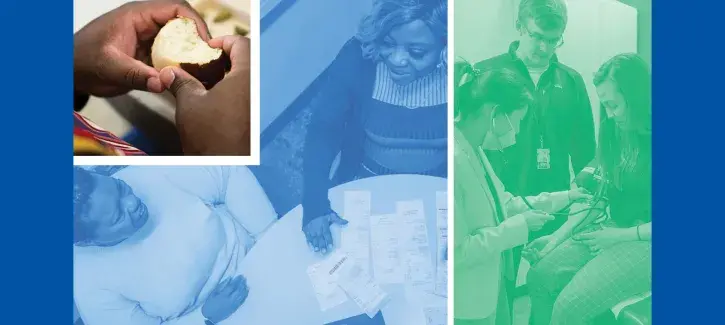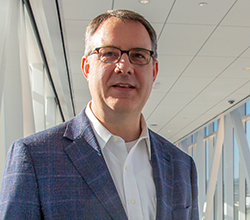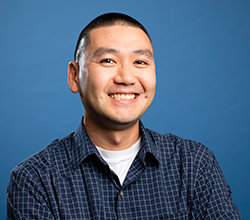
Health equity: The next frontier in healthcare

A quiet revolution in the way healthcare is managed in the United States is gaining ground as healthcare, public health and community-based organizations; governmental agencies; and educational institutions acknowledge the impact of social inequities on health outcomes.
It is a reshaping of America’s approach to healthcare that Creighton’s Institute for Population Health (IPH) has embraced and promoted as it helps guide health sciences education and healthcare delivery toward greater access and equity.
Scott Shipman, MD, MPH, CyncHealth Endowed Chair for Population Health and executive director of the Institute for Population Health, says he is encouraged by recent moves by public and private accreditation agencies to gather data on how healthcare institutions address health-related social needs.

“They are not yet requiring anything other than screening for social needs and reporting that the screening has been done, on how many patients it’s been done, and the percent of patients that were positive for the various things that are being screened for,” he says.
What regulatory requirements eventually emerge from this data collection, and whether a more holistic approach to healthcare develops, is something Shipman is monitoring closely.
“This opportunity to coordinate healthcare and community health more overtly very much aligns with the Institute for Population Health’s work partnering with others to improve health equity and improve the health of our communities,” he says.
The IPH, which launched in 2023, serves as a hub and a source of Creighton health initiatives designed to help underserved communities attain better health outcomes. Pointing out that 80% of factors affecting health outcomes are social and economic rather than issues typically handled by healthcare systems, Shipman advocates a wider approach.
Reducing Health Inequities
The Centers for Medicare and Medicaid Services, the federal agency that provides health coverage to more than 160 million Americans, along with two private accreditation agencies, the Joint Commission and the National Committee for Quality Assurance, are leading the effort to identify new requirements that could reduce health inequities, which are known to be pronounced among racial and ethnic minorities.
The factors that may contribute to worse health outcomes for racial and ethnic minorities are many, Shipman says, and unmet health-related social needs are prominent sources of inequities.
Difficult questions must be asked, he says, if a true picture is to emerge of the impact of social needs on health outcomes. And they must be asked with personal and cultural sensitivity.
Among these questions are patients’ ability to provide adequate food for themselves or their families, the availability of transportation, whether bills are going unpaid or exposure to domestic violence. Who asks those questions, how they are asked and whether the interviewer appears rushed due to a heavy workload, will all play a role in obtaining honest data, without which effective solutions cannot emerge.
“And then,” he says, “if a patient screens ‘Yes, I have trouble putting food on the table,’ then a follow-up question is, ‘Do you want help with that?’ If the patient says no, what is the protocol for the hospital? Do you just ignore the problem, or do you do something to help the patient get more comfortable with seeking help?”
Healthcare institutions need guidance on such matters, and Shipman says he expects the data assembled for the regulatory agencies will catalyze a way forward.
Researching Health-Related Screenings for Social Needs
Creighton is in the vanguard of such efforts, not only through the work of the IPH, but also through the work of its researchers.
Joy Doll, OTD’03, associate professor and director of the Health Informatics Program, says a team of Creighton researchers has joined with CHI Health to address health-related screenings for social needs. The research is funded by a grant from Creighton’s Dr. George F. Haddix Presidential Faculty Research Fund.

In addition to Doll and Shipman, the team includes Waddah Al-Refaie, MD, chair of surgery for the Department of Surgery at Creighton and CHI Health, and Rebecca Ann Davis, BSN’00, DNP’13, assistant professor of nursing.
The federal mandates, which were issued in 2024, require screening hospitalized patients for a fixed set of social needs. Clinical workflows have been redesigned, Doll says, and coding systems created, to screen for these needs and to support what the Centers for Medicare and Medicaid Services terms “community health integration.”
“One area where patients often need support is after a surgical procedure,” Doll says. “To recover, patients need a safe and stable environment, which can be impacted by social needs.”
She says the research team conducts interviews with clinicians involved in these new processes and will review the data collected.
“The approach is to use the lived experience of the clinicians and patients, along with health data, to provide guidance on many unanswered questions surrounding these new requirements,” Doll says. “The project began this summer with results arriving in the next few months and a goal to improve the patient and clinician experience while optimizing care and building infrastructure that can impact health disparities.”
First Steps Being Taken
The development of social needs awareness among healthcare institutions and practitioners will be a long journey, says Ashley Carroll, but first steps have been taken.
Carroll directs the healthy communities team at CHI Health, while also serving as a member of the IPH team.
“We are leveraging screening data to derive insights for our population health efforts,” Carroll says of her work at CHI Health. “Broadly, the healthy communities team translates insights from social-needs’ screening into action in the community.”
Such action involves working with other health systems and with social service agencies such as food pantries and shelter services.
It is important, Carroll says, that those partnerships be built while bearing in mind what she terms the “fragility” of partners such as food pantries and shelters, which typically have limited resources to serve the patient population of large healthcare institutions.
The construction of health systems and community programs and partnerships is an important aspect of the push to address social inequities, Shipman says, and bodes well for the future, as health systems and higher-education institutions with health sciences programs such as Creighton’s embrace social needs’ concerns.
“All of this, almost without exception, is outside the general training of today’s physicians, nurses and others,” he says. “It will become increasingly critical to understand how to think holistically about a patient’s needs.
“You might be the best diagnostician in the world and have all of the right resources at your disposal to prescribe the right medications, the right treatments, imaging, etc., but if your patient can’t reliably get transportation to go and get that imaging or doesn’t have the ability to pay for a prescription, your best efforts to help the patient get healthier will be thwarted.”
Training the Next Generation of Healthcare Providers
Creighton’s health sciences programs need no push from private or federal agencies to acknowledge the importance of social determinants of health, says Kevin Fuji, PharmD’07, associate professor of pharmacy sciences in the School of Pharmacy and Health Professions and faculty research lead for the IPH.
“Regardless of any accreditation requirements there is an overall recognition that we cannot treat our patients in the most effective way unless we understand the context of their daily lives and their ability to care for themselves and for others,” he says.
“Addressing social determinants of health is a core part of cura personalis, and when Fr. Hendrickson [Creighton president] talks about how a ‘Creighton physical therapist’ or a ‘Creighton nurse’ or a ‘Creighton pharmacist’ is different, this aspect of training is a large part of what I believe he is talking about.”

This difference, Fuji says, is exemplified in clinical efforts that serve diverse and underrepresented populations, such as Creighton’s dental clinic; the Magis Clinic, established by medical students, which provides free healthcare and referral services at the Siena Francis House shelter in Omaha; and the School of Law’s Juvenile Justice Legal Clinic, which offers public office hours at the Creighton Highlander community center in north Omaha.
It is also found in research projects, such as the Cura Project, which addresses social determinants of health related to financial stress and food insecurity in local individuals with type 2 diabetes. Fuji and Nicole Gillespie White, PharmD’10, associate professor of pharmacy practice, serve as lead investigators on the project.
All of these efforts, and others similar, build student awareness of the impact of social needs on health outcomes, Fuji says.
Shipman welcomes this embrace of social determinants of health factors.
“Increasingly, the world that finances healthcare is recognizing that these things matter,” he says. “So, if our next generation of clinicians and other healthcare professionals are not ready for it, are not recognizing it, are not understanding the nuances of it and are not able to better work between the health system and the community than we do today, we are not going to take many steps forward.”
In a word, Shipman says, the incorporation of social needs into overall healthcare is going to become systematic.
“New regulations, by virtue of being requirements, will force health systems to be more systematic and to look for and understand health-related social needs that the patients have,” he says.
“Previously, this was done sporadically by some systems, and by some individual clinics, but this is a more systematic push, at least for inpatients — people who are in the hospital. Like any big change in healthcare, how it’s implemented really is critical to whether this is ultimately valuable or not.”
Speaking as the director of an institute that recognizes and seeks to reduce social inequities in healthcare, Shipman says the accreditation agencies are addressing issues that did not come into full view until the COVID-19 pandemic.
“I think there was always a widespread recognition, but really put into sharp relief by the COVID-19 pandemic, that there are unacceptably large disparities in health and healthcare — access to care, quality of care, outcomes of care — across different groups of individuals, and certainly leading in those disparities are racial and ethnic disparities.
“There is now a push to act on these disparities as being unacceptable. It’s a very complex, multifactorial challenge, but it’s a challenge that some payers, including Medicaid and many health systems, are taking on.”
Social Determinants of Health
The Social Determinants of Health are defined as nonmedical contributors to health outcomes. While lists may differ slightly, they often include:
- Healthcare – It’s estimated that one in 10 people in the U.S. is without health insurance and therefore may not be able to afford necessary healthcare services and medications.
- Behaviors – Individual behaviors such as smoking, substance use, diet, physical activity, sleep and risky sexual activities all contribute to health and mortality.
- Physical Environment – Neighborhoods with high rates of violence, unsafe air or water and other risks have a negative effect on health. Racial and ethnic minorities, and people with low incomes, are more likely to live in such places.
- Social Elements – Discrimination or trouble affording life’s necessities can impact health and safety. Positive relationships at home, at work and in the community can reduce these impacts.
- Economic Influences – It’s estimated that one in 10 people in the U.S. lives in poverty, unable to afford healthy foods, healthcare and housing. People with steady employment are more likely to be healthy.
(Sources: U.S. Department of Health and Human Services, National Institutes of Health)
Health Disparities Remain a Challenge in U.S.
A study published in 2024 by KFF, formerly known as the Henry J. Kaiser Family Foundation, found that healthcare disparities rooted in racial identity remain a challenge for the U.S. healthcare system. The report found that “Black, Hispanic and AIAN (American Indian and Alaskan Natives) people fare worse than white people across the majority of examined measures of health and healthcare and social determinants of health.” Among the study’s key takeaways:
- Uninsured – Nonelderly AIAN (19%) and Hispanic (18%) people were more than twice as likely as their white counterparts (7%) to be uninsured as of 2022.
- Life Expectancy – AIAN (67.9 years) and Black (72.8 years) people had a shorter life expectancy compared to white people (77.5 years) as of 2022, and AIAN, Hispanic and Black people experienced larger declines in life expectancy than white people between 2019 and 2022. However, all racial and ethnic groups experienced a small increase in life expectancy between 2021 and 2022.
- Infant/Pregnancy Mortality – Black (10.9 per 1,000) and AIAN (9.1 per 1,000) infants were at least two times as likely to die as white infants (4.5 per 1,000) as of 2022. Black and AIAN women also had the highest rates of pregnancy-related mortality.
- Food Insecurity – AIAN (24%) and Black (21%) children were more than three times as likely to have food insecurity as white children (6%), and Hispanic children (15%) were over twice as likely to have food insecurity than white children (6%) as of 2022.




